In this topic we look at the specific codes of welfare for companion cats and companion dogs. These are the only two companion animals in this programme that have specific codes of welfare. The codes sit under the Animal Welfare Act 1999 and the Animal Welfare (Care and Procedures) Amendment Regulations 2020. Note: The Animal Welfare (Care and Procedures) Amendment Regulations 2020 are additions to the Animal Welfare (Care and Procedures) Regulations 2018 from earlier in this Module, but do not affect the content of this course as the amendments refer to non-companion animals.
MPI has provided pdf versions of both codes – you can download a copy to keep for your own records. The link is here: All animal welfare codes | NZ Government (mpi.govt.nz). There is a lot of really useful information in both of these documents, and we will refer to them again in other modules. In this module, our focus is solely on the minimum standards of welfare required by the two codes.
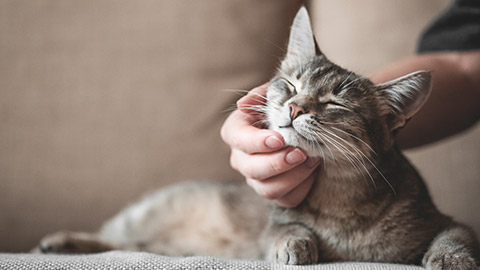
Cats are the most commonly owned companion animals in New Zealand. Unlike commercially farmed animals, the vast majority of cats are kept for their intrinsic nature as loved and loving companions.Code of Welfare: Companion Cats
Code of Welfare: Companion Cats
| Purpose: | To provide information to owners or people in charge of companion cats about what they must do to meet their obligations under the Animal Welfare Act 1999. |
| Enforced/administered by: |
|
| Key Points: |
|
Adopting or Purchasing a Cat
Responsibility of seller:
- Provide the new owner with printed information for settling the cat into its new environment and for its ongoing care.
- Provide details of the cat’s vaccinations, flea and worming treatments.
Responsibility of new owner:
- Become familiar with the responsibilities of ownership and be prepared to undertake those responsibilities for the life of the cat.
- Let’s look at how this happens at Emily’s workplace.
Case Study
Adopting a Cat from the SPCA
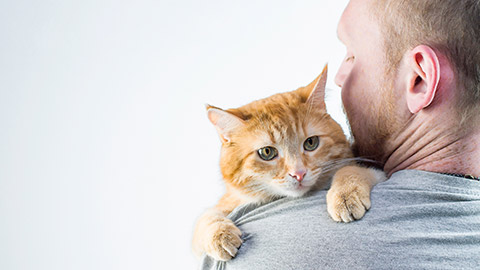
Emily is pretty happy today. Mango, an older cat surrendered by his past owner, is being adopted by Noah. Noah initially came to adopt a kitten but connected with Mango when he saw him in the quarantine section for cats who have been exposed to viruses. Mango is an extremely calm and laidback cat, and Emily had been hoping that he’d find a new home quickly.
Emily: Here’s your adoption folder Noah. In it you will find all of Mango’s medical records, including from his previous owner and the notes our vets have made here. Mango is fully up to date with his vaccinations and received treatment for fleas and worms when he arrived. He has also been spayed, so you don’t need to worry about that. As you know, he has been exposed to feline calicivirus which means he could be a life-long carrier. Stress can sometimes cause the virus to flare up, so keep an eye out for the symptoms. A brochure on this has been included in your adoption folder, as well as some other helpful information on settling cats into a new home. There’s also information on feeding him.
Noah: That’s great, thanks Emily. Is there anything else I need to know?
Emily: Mango’s pretty laid back, but he might still find the first week or so with you to be stressful. Keep him inside until he appears comfortable. It will also help if you feed him the same food as he has been receiving here.
Noah: Why is that? I was planning on using one of the brands at the supermarket.
Emily: It’s best to change a cat’s diet gradually as sudden changes cat cause stomach upsets for cats.
Noah: That makes sense. I plan to keep him inside. Do you think this will be a problem?
Emily: No, so long as you make sure his toilet area is kept clean, he has enough food and water, and that he has plenty of enrichment activities and attention from you, he should be fine as an indoor cat. The local bird life will be safe as well!
Check what the Code of Welfare for cats says about adopting a cat. How well do you think Emily did in her role as an SPCA worker?
Food and Water
Important: cats are obligate carnivores, which means that the nutrients they need to be healthy come from a varied meat-based diet. Vegetarian OR only lean meat (no offal, fat or bone) diets are not regarded as suitable for cats. Vegan diets for cats sometimes get promoted on social media as the better ethical choice for cat food, but this is not supported by the Code of Welfare, nor is the debate around this part of the requirements for learning in this Module.
Minimum standard No. 1 of the Code of Welfare for cats states:
Minimum Standard No, 1- Food and Feeding.
- Kittens that have been weaned must be fed a minimum of twice a day.
- Cats over the age of 6 months must be fed at least once a day.
- Cats must receive adequate quantities of food and nutrients to enable each cat to:
- maintain good health; and
- meet its physiological demands, including those resulting from pregnancy, lactation, growth, exercise and exposure to cold; and
- avoid metabolic and nutritional disorders.
Source: All animal welfare codes | NZ Government (mpi.govt.nz).
If the minimum standards are followed then the body condition of an adult companion cat should easily be maintained. Minimum Standard No. 2 states:
Minimum Standard No. 2- Body Condition
- When a cat’s body condition score is “thin” as defined in Schedule II- Assessment of Body Condition of Cats, remedial action through veterinary attention or improved nutrition must be taken.
- A cat’s body condition score must not be allowed to fall bellow “thin” as defined in Schedule II- Assessment of Body Condition of Cats.
A light layer of fat over the ribs and only a little abdominal fat is healthy for an adult cat. A vet will check for this while inspecting a cat and advise if the cat is too thin.
Note: “chonky cats” are popular on social media, but like humans, excessive weight in cats can increase the chances of disease and poor health.
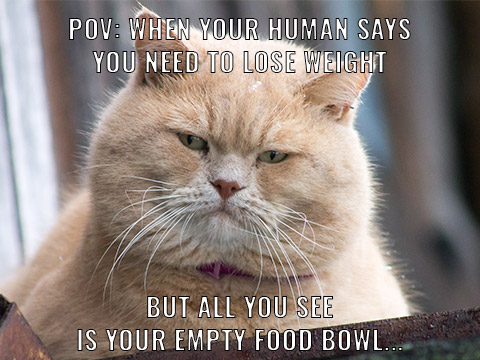
Cats need water, especially if they are being fed dry food. The amount of water needed will also depend on the cat themselves but the minimum standard for a cat is that palatable water should be available at all times. Palatable water means ‘pleasing to the senses’. This differs from cat to cat – some cats are fussy; others will drink from puddles or out of a toilet. Owners of cats should keep fresh water available.
Minimum Standard No. 3- Water
Cats must have continuous access to water that is palatable and not harmful to health.
Housing and Hygiene
Cats are drawn to warmth and sunlight, so this is important to consider when housing them. In the home cats do not typically need to be caged, but in situations where owners are away from the house and the cat has access to the outdoors, the comfort and security of the cat should be considered.

In places where cats need to be caged, such as a cattery, the placement and number of cages is important to ensure the health and wellbeing of the cats contained in them. The minimum standard for caged cats requires sufficient room to move and the opportunity for exercise and play.
Minimum Standard No. 4- Caged Cats (Other Than for Transport)
- Caged cats must have sufficient room to enable them to stretch and move around freely, and must be provided with appropriate areas for feeding and toileting.
- Caged cats must be provided with the opportunity to engage in play and exercise daily.
Whether caged or uncaged, areas that cats use should be kept clean. This includes food and water dishes, litter trays and bedding. This is particularly important when there are a number of cats in the same household or confined area, as diseases can spread quickly.
Minimum Standard No.5- Hygiene
- Food and water bowls must be washed regularly to prevent contamination that may pose a threat to the health and welfare of the cat.
- Cats kept indoors, and caged cats, must have access to a litter tray containing absorbent material.
- Litter trays must be attended to regularly, with faeces and moisture-laden litter removed, to prevent contamination that may pose a threat to the health and welfare of the cat.
Breeding
Feral (wild) cats are a big environmental problem in New Zealand, and one of the contributing factors is that cats breed quickly. Unwanted kittens are often abandoned, and those that survive can form feral cat colonies that are lethal to native New Zealand fauna. It’s recommended that cats be de-sexed to stop them breeding. Cats adopted from shelters are usually de-sexed, or the shelter will offer easy options for new owners to access de-sexing surgery when the cat is old enough.
Cat breeders should consider the health and wellbeing of their breeding animals and allow appropriate time between litters. Kittens will be weaned by 8 weeks, but it is recommended that they stay with the mother cat for longer than this so that they can learn appropriate cat behaviour. Cats that are socialised with both humans and other cats will make better companions.
Minimum Standard No. 6- Removal of Kittens from the Queen
Kittens made available for sale or rehoming requiring removal from the queen must be in good health and must be at least 8 weeks of age, except when they have been orphaned and cannot be fostered to another queen or where early removal from the queen is deemed necessary by a veterinarian.
Health
Owners and people in charge of cats are responsible for preventing ill health and treating it when it occurs. Ownership of a cat should involve knowing the signs and symptoms of poor health and checking for them regularly. The older the cat, the more often the cat should receive official health checks.
Minimum Standard No.7- Signs of Ill Health
- Cats which are observed by their owners or persons in charge to be showing:
- signs of significant pain, suffering and distress; or
- signs of repeated straining over a continuous period of 30 minutes, as if to pass urine or faces; or
- signs of rapidly deteriorating health must URGENTLY receive veterinary attention, be rough tot the attention of an inspector under the Act (e.g. and SPCA inspector) or be humanely euthanised.
- Cats which are observed bu their owners or persons in charge to be showing:
- signs of chronic pain, suffering and distress; or
- signs of deteriorating health must receive veterinary attention, be brought to the attention of an inspector under the Act (e.g. an SPCA inspector) or be humanely euthanised.
Some cats may require assistance with grooming or declawing. Declawing must be done by a vet, or under the supervision of a vet.
Cats that have access to the outdoors are at risk of injury, especially on roads. Owners or people in charge of cats are responsible for minimizing that risk as much as possible. If a cat is seriously injured, then the minimum standards of the Code require that the owner/person responsible for the cat seeks appropriate medical attention.
Minimum Standard No. 8- Injured Cats
Cats which are observed by their owners or persons in charge to be significantly injured must receive urgent veterinary attention, be brought to the attention of an inspector under the Act (e.g. an SPCA inspector) or be humanely euthanised.
Collars for cats do double duty as a health precaution against fleas and a way of identifying the cat, but they can also be a health risk. Collars should have a quick release feature, so it is recommended that cat collars are purchased from an appropriate supplier. It’s not appropriate to use another kind of collar.
Minimum Standard No. 9- Use of Collars
Collars, where used, must be fitted to the cat in such a way that the risk of injury to the cat is avoided.
Cat behaviour
It’s easy for new owners of cats to misunderstand what natural cat behaviour is. Scratching to sharpen claws and spaying to mark territory are normal cat behaviours that are often seen as undesirable by their human owners. These behaviors can sometimes worsen if the cat is stressed, and they cannot be ‘punished’ out of the animal. The best strategy is to provide the cat with opportunities to practice these normal behaviours in ways that humans can live with. Remember that the Animal Welfare Act 1999 states that animals must be allowed to demonstrate their natural patterns of behaviour.

Identification for Cats
We have already mentioned collars as a means of identifying cats, but the best option is to have them microchipped. Some cats wander and can become lost, and a microchip means they can easily be reunited with their owners. It also helps in cases where ownership of the cat is questioned, or in situations where the cat has passed away in a location other than the owner’s property.
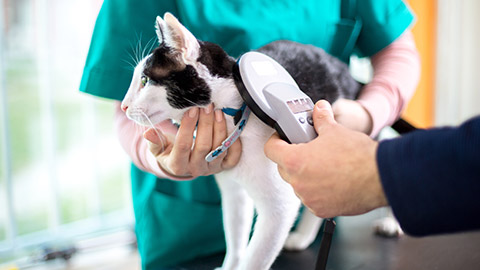
Transportation of Cats
Cats are creatures of routine and habit and the combination of being caged and transported can cause them stress and anxiety. Owners or people in charge of cats should choose cat carriers that help the cat feel secure and keep them safe. It’s important that cats being transported have adequate air and that they do not overheat.
Minimum Standard No. 10- Transportation
- While being transported in a vehicle, cats must be carried in a secure container.
- Cats being transported must have sufficient space within the container to stand, turn around and rest normally.
- There must be adequate provision for ventilation in the form of multiple holes on at last three sides of the container.
- The interior of the container must be smooth, with no projections that could cause injury to the cat.
- Cats must not be left unattended in a vehicle when heat is likely to cause distress to the cat.
Case Study
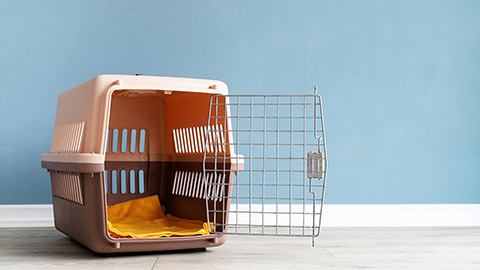
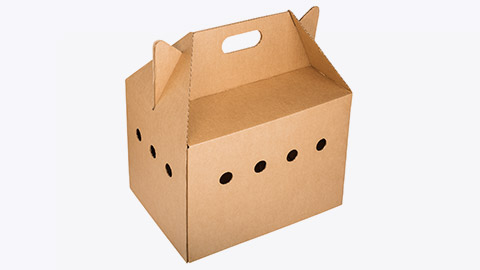
Aroha: Kia ora! Can I help you with anything?
Customer: I’m looking for a carrier for my cat.
Aroha: How often do you think you will need to use it? Will you be transporting the cat very far?
Customer: We’ll use it every couple of months as we will take our cat with us to our holiday home. It’s an hour’s drive away.
Aroha: Then I recommend this one.
Giving Up a Cat
We mentioned earlier that feral cats are a problem in New Zealand. Sometimes, people abandon their animals because they are moving or they can’t care for them any longer. Some abandoned cats survive and become feral, but in many cases, an abandoned cat is likely to die without human care.
Abandoning a cat is an offence under the Animal Welfare Act 1999. It is also completely unnecessary because there are other options available for re-homing a cat, even if the current owner is struggling financially or with transport.
Activity
If someone that you knew told you that they were going to abandon their cat because they could no longer provide care for it, what advice or assistance would you give them without offering to take the cat yourself? Research the options that are available in your area and share them in the forum.
Euthanasia
This term means to quickly and painlessly put to death. It is the kind and humane action to take in situations where the cat is too ill or injured to recover or to have a pain-free quality of life.
It’s best done by a vet to ensure that no unnecessary suffering is caused to the cat. It is an offence under the Animal Welfare Act to kill any animal in such a way that causes it unreasonable or prolonged pain and suffering.
Minimum Standard No. 11- Euthanasia
- When a cat is euthanised, it must be carried out in such a way as to ensure that death occurs quickly.
- Cats (including kittens) must not be killed by drowning.
Feral and Colony Cats
These are not regarded as Companion Cats, but it is worth noting that people or organisations who interact with the cats in certain circumstances to improve their well-being may be regarded as having some of the responsibilities outlined in the Code of Welfare for Cats or under the Animal Welfare Act.
Activity
To recap about the Code of Welfare for cats, have a go at this activity. You’ll need to have a good grasp of the Code for your assessment, so this will let you know how well you are doing. To challenge you, the questions are not in the same order as they appear in the Code.
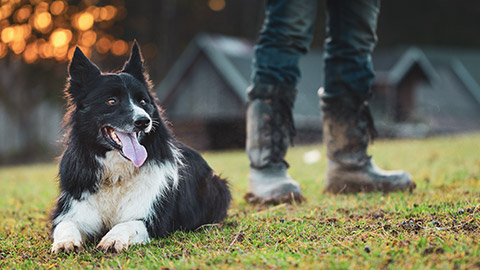
Dogs are valued within New Zealand society both as companions and working animals.Code of Welfare: Companion Dogs
Code of Welfare: Companion Dogs
| Purpose: | To provide information to owners or people in charge of companion dogs about what they must do to meet their obligations under the Animal Welfare Act 1999. |
| Enforced/administered by: |
|
| Key Points: |
|
The Code of Welfare for dogs includes working and sport dogs in the definition of Companion Dog. It does not include fighting dogs as this is an offence under the Animal Welfare Act.
Owning or Adopting a Dog
Dog ownership is a big responsibility and one that many people underestimate. It’s important to choose a dog that will match the lifestyle of the owner or the working needs that the dog is expected to fulfill. Many dogs are rehomed because the new owner did not have a good understanding of the dog’s needs or its natural behaviours. Researching dog breeds and their characteristics before making a decision to adopt is the best approach to take.
Change of Ownership
As we covered in the section about the Code of Welfare for Cats, it’s an offence under the Animal Welfare Act 1999 to abandon an animal, including a dog. There are plenty of options available to help find a suitable new home if rehoming is necessary.
According to the Dog Control Act 1996, dogs must be registered at the local council, and it is up to both the previous AND the new owner to contact the council to update the details of the registration.
You can read about the Dog Control Act 1996 here: Dog Control Act 1996 No 13 (as at 30 November 2022), Public Act – New Zealand Legislation
Food and Water
Nutrition needs of dogs depends on their size and age, as well as their current state of health, sex, growth rate and amount of exercise that they require and are getting. Like cats, a lean meat only diet (no fat, offal or bone) is not suitable for dogs. Bone, intestinal meats (offal) and fat all contain things that dogs need to be healthy that cannot come from lean meat alone. Unlike cats, dogs are not obligate carnivores (only eat meat) and a diet that includes a small amount of plant-based food alongside meat-based food will provide them with a balanced diet. Note though that some plant-based foods are not good for dogs.
Tip
Chocolate is bad for dogs. According to Hill's Pet Nutrition, the compounds in chocolate that make it so attractive to humans are toxic to dogs. The effect of eating chocolate will depend on the size of the dog, the type of chocolate and how much the dog ate, but the general advice is that your dog should not eat your chocolate.
Source: Why Chocolate is Bad for Dogs | Hill's Pet (hillspet.com)
From weaning (approximately 6 weeks) until about 4 months old, puppies will need three to four small meals a day. This will gradually decrease to one meal a day, although this will depend on the breed of the dog and the amount of exercise it is getting. By nine months of age, most dogs should be on an adult diet in terms of the amount of food that they need.
Important: Dogs will eat food very quickly and are therefore at risk of choking on small pieces of solid foods. Small bones such as those found in fish or chicken should not be given to dogs. Large raw bones are suitable.
Minimum Standard No. 1- Food and Feeding
- Dogs must receive adequate quantities of nutritious food ato enable each dog to:
- maintain good health;
- meet its physiological demands, including those resulting from the level of physical activity, growth, pregnancy, lactation and exposure to cold; and
- avoid metabolic and nutritional disorders.
Source: All animal welfare codes | NZ Government (mpi.govt.nz).
The ideal body condition for dogs, which does also depend on breed, is similar to cats. There should be a light layer of fat over the ribs and the dog should have a visible waist with minimal abdominal fat. Body shape in dogs does vary more than that of cats: some breeds of dogs are naturally lean (such as Grey Hounds); while other dogs are stockier (such as bulldogs). However, obesity in all dogs is not good for their health. Vets use a body composition scoring system to determine if a dog is under or overweight.
Minimum Standard No. 2- Body Condition
- If a dog is exhibiting a body condition score “thin” ( as defined in Schedule II: Assessment of Body Condition of Dogs) in conjunction with any other physical or behavioural indicators of malnutrition appropriate remedial action through veterinary attention or improved nutrition must be taken.
- If a dog is exhibiting a body score “grossly obese” (as defined in Schedule II: Assessment of Body Condition of Dogs), veterinary advice must be sought and remedial action taken to decrease body weight using a planned exercise programme to increase energy expenditure and dietary modification to reduce energy intake.
Water is very important to dog health, especially for working dogs, dogs in hot climates, and dogs that exercise a lot. Dogs that eat dry food will need extra water. The water should be clean and palatable.
Minimum Standard No. 3- Water
Dogs must have frequent access to water, appropriate to their needs, that is palatable to the dog, not harmful to health and available in quantities sufficient to maintain vital bodily functions.
We will cover nutrition for dogs in more detail in another module.
Containment of Dogs
Owners or people in charge of dogs are required to keep them under control at all times. This helps keep them safe from harm and also prevents them from becoming a nuisance. This does not mean keeping them short-chained or caged for long periods of time as it is important for dogs to be able to move around. This is part of their natural pattern of behaviour protected under the Animal Welfare Act 1999.
If kept outside, dogs need dry and shaded shelter. If a secure fenced area is not possible then a kennel with an attached run or tether line is recommended by the Code of Welfare for Dogs.
Minimum Standard No.4- Containment and Tethering
- Dogs must not be contained or tethered in a way that causes them injury or distress.
- Any collar or tether on a dog must not-
- cause a cut that bleeds or discharges; or
- cause a skin abrasion that bleeds or discharges; or
- cause a swelling; or
- prevent the dog from breathing normally, panting or drinking.
However, the SPCA has been campaigning against the tethering and confinement of dogs for several years. Proposed changes to the regulations around this were submitted for public consultation in early 2023. There has not been a decision made by the government at this point in time (late 2023). You can read about it here: Chained Dogs (spca.nz)
If dogs are kept in kennels, then the kennel needs to be warm, dry, and draught free with enough room to stand, lie down and turn around. Dogs can be kept in communal kennels in places like animal shelters, or on farms provided they interact well with each other. In these situations crowding and hygiene need to be considered to make sure the health and wellbeing of the dogs in the communal spaces is not affected.
Minimum Standard No.5- Kennelling, Shelter and Ventilation
- Dogs must have access at all times to a lying area that-
- is large enough to allow the dog to stand up, turn around, and lie down in a natural position; and
- is fully shaded: and
- is dry: and
- is ventilated.
- Dogs must be provided with protection from extremes of heat and cold.
- Measures must be taken to enable dogs to keep warm in cold weather.
- Dogs must have access at all times to water.
- Dogs must have access at all times to an area in which to urinate and defecate away from their lying area.
- Faeces and urine must not be allowed to accumulate in any area in which the dog is kept.
Case Study
Purchasing a new kennel
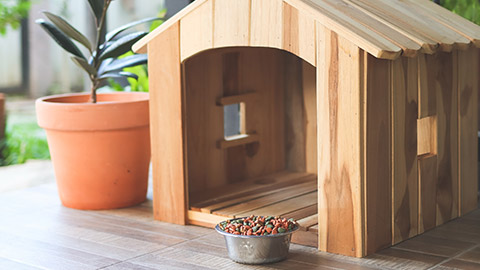
Aroha notices a family looking at dog kennels and asks them if they would like any help in deciding what kennel to buy. They tell her that they would prefer not to spend a lot of money and ask her what she would recommend.
Aroha knows what the minimum standards are around kennel size, so she asks the family how big their dog is. They tell her that it’s a mixed breed female puppy about 5 months old, but the mother is a Rhodesian Ridgeback, and the puppy looks like it will have most of the features of a Rhodesian Ridgeback. She then asks them if the puppy will be an indoors or outdoors family member. The family tells her that they have a large fully fenced backyard that the puppy will have free access to. The kennel will be placed in a sheltered area near to their house.
Based on this information, Aroha shows them the kennels that would best suit an adult of this type of dog.
Activity
Find out about Rhodesian Ridgebacks online. Then look at the Code of Welfare for Dogs and identify what size kennel that you think Aroha would have recommended.
All animal welfare codes | NZ Government (mpi.govt.nz).
Sanitation and Hygiene
Areas where dogs spend most of their time need to be kept clean. This includes:
- Removing urine and faeces regularly
- Washing and disinfecting kennel areas and food and water bowls
- Checking bedding or mats for pests like fleas or parasites, and washing them regularly
Minimum Standard No. 6-Sanitation
- Faeces and urine must not be permitted to accumulate to such an extent that they pose a threat to the health or welfare of the dog.
- Food and water containers must be kept clean of contamination that may pose a threat to the health or welfare of the dog.
Breeding
Owners who plan to breed dogs must ensure that the breeding process does not result in puppies that have poor health, poor temperament, physical deformities or genetic disorders that can then be passed on to their offspring.
Minimum Standard No. 7- Breeding
Breeders must make all reasonable efforts to ensure that the genetic make-up of both sire and dam will not result in the frequency or severity of known inherited disorders.
Owners who plan to breed dogs should also consider whether they will be able to find suitable homes for all of the puppies. In New Zealand there are usually more dogs and puppies needing homes than there are people who are available to take them in. This can lead to dogs and puppies being dumped/abandoned, or mistreated. De-sexing dogs reduces this issue and is also better for their general long-term health and wellbeing.
Breeding dogs should be in good health and of an appropriate age for breeding. This can be as young as ten months for smaller dogs and 16 to 18 months for larger dogs. Gestation (pregnancy) is about two months. Giving birth for dogs is known as whelping.
Minimum Standard No. 8- Whelping
- Bitches that are due to whelp, or are whelping, must be provided with a suitable whelping area in a safe, warm and quiet environment.
- Butches that are due to whelp must be inspected frequently to ensure that they are not experiencing whelping difficulties.
- If a bitch is exhibiting any signs that indicate that she is experiencing difficulties at any point during whelping, expert assistance must be sought.
Puppies need milk for the first few weeks of their lives. At 3-4 weeks solid food may be introduced, and puppies may be weaned from their mother at 6-7 weeks. They should not be re-homed before this time. The best age to rehome is after 8 weeks, as this will have allowed the puppies time to learn socialisation behaviour from the mother dog. It’s best that puppies also become used to human handling before being rehomed. Socialised dogs make better human companions.
Minimum Standard No.9- Supply of Puppies
- Puppies must be able to feed independently and be in a good health when made available for sale or rehoming, unless:
- they have been orphaned and must be rehomed to ensure that they are able to obtain milk from another bitch or be hand raised; or
- early removal from the bitch is deemed necessary by a veterinarian.
- People supplying puppies must, at the time of supply, disclose to persons receiving them, any known inherited disorders that the puppy or adult dog may be predisposed to which may cause health and/or welfare problems during the dog’s lifetime.
Health
As we have already learned from the Animal Welfare Act 1999, owners have responsibility for the health and wellbeing of their dogs, and to treat them or seek expert advice when the dogs need it.
Minimum Standard No. 10- Ill Health and Injury
- Owners, or persons in charge of dogs, who observe their dogs to be showing:
- signs of significant acute pain, suffering and distress; or
- signs of chronic pain, suffering and distress; or
- signs of rapidly deteriorating health;
- serious injury must seek immediate attention from a veterinarian or appropriately trained animal health practitioner.
- If a dog is suffering from pain or distress that is extreme or untreatable, then the animal must be euthanased.
Poor health in dogs can be prevented by good nutrition, appropriate exercise, a clean and safe place to live, vaccination, flea and de-worming treatments, and regular veterinary check-ups. Some diseases can be passed from dogs to humans. This will be covered in another module.
Minimum Standard No. 11- Prevention of Infectious disease
Dogs known to be infected with an infectious disease must be carefully supervised and securely isolated so as to prevent infecting other dogs.
Dogs benefit from regular washing/bathing, and in the case of long-haired dogs, regular grooming to maintain their coats and prevent infection from parasites. Some dogs may need their claws clipped to maintain good paw health. This is not the same as dewclaw removal, that we learned about earlier in this module.
Minimum Standard No. 12- Care of Claws and Coat
- The coats of long-haired dogs must be groomed and/pr clipped at a frequency that will prevent suffering and distress due to matting or infestation by parasites.
- Claws must be clipped when necessary to avoid penetration of the skin and/or foot pads.
Case Study
Bucky’s regular appointment
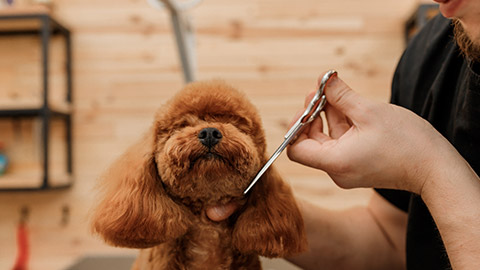
One of Caleb’s favourite doggy clients has his regular appointment today. Bucky usually comes in for washing and grooming. He has quite thick and soft fur that needs to be kept short, and Caleb really enjoys shaping his fur during the grooming process as Bucky is a handsome little poodle. Bucky is a show dog and doesn’t spend much time outside, so as part of his grooming process Caleb checks his nails and trims them if they are getting a little long.
Activity
Is Caleb allowed to trim Bucky’s nails? Check the Code of Welfare for Dogs and find out.
All animal welfare codes | NZ Government (mpi.govt.nz).
Exercise
Dogs are made to move! Not getting enough exercise can lead to physical and mental issues. Keeping dogs confined for long periods of time without adequate exercise is denying them their natural patterns of behaviour.
Minimum Standard No. 13- Exercise
- Dogs must receive daily exercise sufficient to maintain their health and well-being.
- Dogs must be supervised at all times when exercising with exercise equipment such as treadmills, to limit the risk of injury or over-exercise.
Note: hot surfaces such as concrete, asphalt and sand can burn the pads on dog paws. It pays to be mindful about where and when dogs are being exercised.
We’ve already mentioned that dogs like to chew things. Exercise away from the home or their usual place of shelter means increased risk of a dog accidentally eating something toxic such as poison-laced bait in areas where pest control is happening. It’s important that they are supervised when being exercised and where appropriate they are kept on a lead. Seek professional help immediately if it is possible that the dog has been poisoned. Either a vet or the NZ Animal Poisons Helpline on 0800 869 738.
Minimum Standard No. 14- Harmful Substances
- Owners and persons in charge of dogs must take all practical steps to ensure that dogs are not exposed to poisons and harmful substances.
- Owners and persons in charge of dogs known to have eaten a harmful substance or showing signs indicative of poisoning (e.g. tremors, fitting, frenzied behaviour, sudden drowsiness or collapse) must seek immediate veterinary attention.
Case Study
Poison in the Park
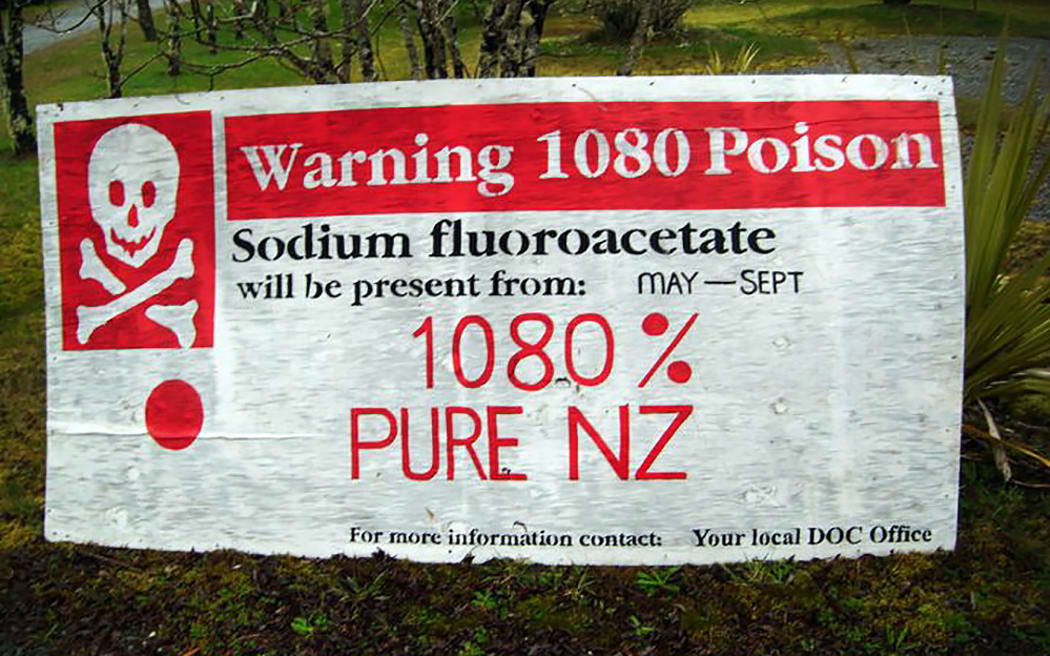
Zoe is always on the look-out for new places to take her doggy clients for exercise. She drives up to a park in Auckland and sees this sign. Then she drives away. It just isn’t worth it to bring the dogs here.
Surgical Procedures
As we have already learned from the Animal Welfare Act 1999 surgical procedures on animals can only be carried out by a vet or by a person in training and under the supervision of a vet. One type of surgery vets are approached about is debarking surgery. Barking can be seen as undesirable behaviour by humans, especially in urban areas where a barking dog can cause issues with neighbours. If behavioural training has not worked some owners may seek to have their dog debarked.
Minimum Standard No. 15-Debarking
Debarking must not be performed unless-
- all suitable means of treating inappropriate barking have been attempted and failed; and
- the debarking is performed by a veterinarian or veterinary student under the direct supervision of a veterinarian throughout he procedure.
We already know about dewclaw removal, but the Code of Welfare for Dogs provides additional detail around this.
Minimum Standard No. 16- Dew Claws
- A front limb first digit (dew claw) or articulated hind limb first digit (dew claw) of a dog of any age must not be removed except by a veterinarian or veterinary student under the direct supervision of a veterinarian throughout the procedure where the dog is given pain relief at the time of the procedure.
- A non-articulated hind limb first digit (dew claw) of dog of four days of age or order must not be removed except by a veterinarian or veterinary student under the direct supervision of a veterinarian throughout the procedure where the dog is given pain relief at the time of the procedure.
- If a non- articulated hind limb first digit (dew claw) of a dog of four days of age is removed by a person other than a veterinarian, that person must possess the knowledge, training and competence, in relation to that procedure, that is necessary to maintain the health and welfare of the dog.
- If first digits (dew claws) are not removed, care must be taken to manage any consequential risks to animal health and welfare.
Another kind of surgery that veterinarians may be asked about is tail docking. In the past this was popular for cosmetic reasons. It is now banned in New Zealand unless it is necessary medical treatment.
Minimum Standard No. 17- Tail Docking
- Tails must not be docked unless all of the following apply:
- the tail is docked by a veterinarian of veterinary student under the direct supervision of a veterinarian throughout the procedure; and
- the tail is docked for therapeutic purposes; and
- the dog is given pain relief at the time of the procedure.
Dog Behaviour
It’s really important that new dog owners understand what normal dog behaviour is. Sadly, many dogs are put down (euthanised) because of perceived behaviour issues. Dogs can respond well to training that minimises some behaviours, but poorly socialised dogs may be difficult to train. As part of a human ‘pack’ some dogs will need extra assistance to help them understand where their place in the pack is – and usually this is not as the ‘top dog’.
Minimum Standard No. 18- Training
Training techniques must be appropriate for the individual dog.
Sadly, sometimes it is the human that needs behaviour training and not the dog: physical abuse is not the best way to teach a dog to show positive behaviour and is an offence under the Act. However, there are a number of physical aids that can be used to help in the behaviour training process, but these are best used by people with experience using them.
Minimum Standard No. 19- Aids for Behavioural Modification
- Training aids, including electronic, training devices, must not be used in a way that causes unreasonable or unnecessary pain or distress to the dog.
- Pinch or prong collars must not be used.
- Muzzles must not-
- cause a cut that bleeds or discharges; or
- cause a skin abrasion that bleeds or discharges; or
- causes a swelling; or
- prevent the dog from breathing normally, panting, drinking, or vomiting.
- However, a muzzle that restricts panting, drinking, or vomiting may be used if-
- the muzzle is used under constant supervision to prevent injury to any human or animal during veterinary treatment or handling; or
- the muzzle is used by-
- an inspector or auxiliary officer while exercising his or her functions, duties, or power under the Animal Welfare Act 1999;
- a dog control officer, dog ranger, or warranted officer exercising his or her functions, duties or powers under the Dog Control Act 1996; or
- the muzzle is used under constant supervision facilitate handling of the dog for therapeutic purposes, including preventative treatment.
Transportation
We’ve already thought about this in the section about the Animal Welfare (Care and Procedures) Regulations. Do you remember what your advice would be for Zoe in buying a vehicle for her new business? Here’s some additional information that she would need to be aware of. Would you change your recommendation for Zoe based on this information?
Minimum Standard No. 20- Transportation
- Dogs must be provided with adequate ventilation when being carried in a vehicle.
- Dogs must not be transported loose in a stock crate with livestock.
- If dogs are carried in a purpose-built transport box fixed to a vehicle, it must be well-ventilated and
- free from exhaust fumes and road dust.
- the dogs must be secured in a way that prevents them from falling or hanging off (for example, secured by a tether or a cage); and
- if a dog is secured by a tether, the tether must be short enough to prevent the dog’s legs from reaching over the sides of the open deck of the vehicle or open trailer, but long enough to allow the dog to stand or lie down in a natural position.
- Farm dogs may be unsecured on the open deck or open trailer of a moving motor vehicle on a public road while involved in driving or managing livestock (for example, when moving livestock from one paddock to another that is down the road).
- A person who leaves a dog in a stationary vehicle must ensure that the dog does not display signs
- of shade-seeking behaviour, as well as 1 or more of the following signs consistent with heat stress:
- excessive panting:
- excessive drooling:
- hyperventilation.
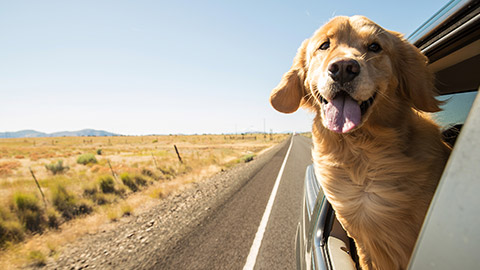
Is there a happier thing to see than the smile on a dog’s face when they are in the car with the window down? The Code of Welfare for Dogs suggests that this could actually be quite dangerous for them, although this is not included in the minimum standards.
Euthanasia
It’s an offence under the Animal Welfare Act 1999 to kill any animal in such a way as to cause it pain and suffering. It’s unfortunately very common for unwanted dogs to be dumped in water ways or deliberately euthanised by drowning. The minimum standard here is the same as for cats – drowning is an offence and not an acceptable option for managing unwanted dogs or puppies.
Minimum Standard No. 21 – Euthanasia
- When a dog is euthanised it must be carried out in such a way as to ensure that death occurs quickly and that pain and distress is minimised.
- Dogs of any age must not be killed by drowning.
There are plenty of other options available to re-home dogs or puppies. Veterinarians in New Zealand report that euthanasia of animals is one of the biggest mental health issues of their role, not to mention the unfairness to animals who are put down because the time hasn’t been taken to explore other options for rehoming them.
Euthanasia is a necessary part of the animal care industry where animals are severely injured or sick but should always be a last resort.
Activity
To recap about the Code of Welfare for dogs, have a go at this activity. You’ll need to a have good grasp of the Code for your assessment so this will let you know how well you are going. To challenge you, the questions are jumbled up and therefore don’t follow the order of the minimum standards as they are set out in the Code.

This Code is relevant if you work at or are intending to work in places like catteries, kennels, animal rescues and shelters, or retail establishments such as pet shops.
| Purpose: | To provide information to people in charge of companion animals on how to house them temporarily. |
| Enforced/administered by: |
|
| Key Points: |
|
Activity
We are going to try a different study method with this Code, because in many ways it is similar to the Codes of Welfare for cats and dogs. Instead of providing you with the key points and some interesting scenarios for you to think about, this activity is going to sharpen your research and study claws (whoops, we mean skills!).
You will be able to write answers to the following questions and then save them as a pdf document which you will be able to keep for your own notes. If you really, really, really want feedback on your notes, you could make a post in the forum and ask your classmates what they think of your answers.
Tip
The best way to learn something is to write it in your own words. While copying and pasting your answer directly from the internet can feel like a good way to record information, it won’t stay in your brain if you choose this method. You probably won’t even read all of the information that you copy. So take your time with this activity and write your own notes – there’s no need to hurry. #betterbrainchoices
Access the code here: Code of Welfare: Temporary Housing of Companion Animals | NZ Government (mpi.govt.nz)
Summary
Wow, tino pai, you’re making great progress! The next topic is a really important one: sustainability. Go check out Topic 5 to find out why.
